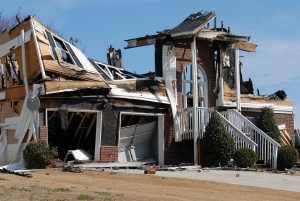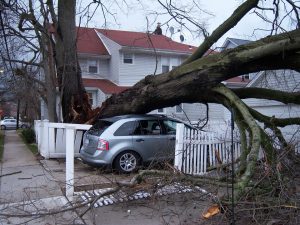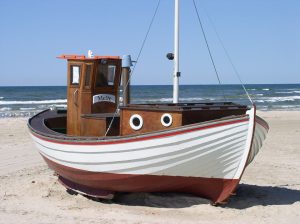Courtesy of iii.org
 What you need to know about
What you need to know about
- how to file a claim
- how the claim process works
- what’s covered and what’s not
First Steps
Contact your agent or company immediately. Find out:
- Whether the damage is covered under the terms of your policy
- how long you have to file a claim
- whether your claim exceeds your deductible (the amount of loss you agree to pay before insurance kicks in)
- how long it will take to process the claim
- whether you’ll need estimates for repairs
Make temporary repairs: Take reasonable steps to protect your property from further damage. Save receipts for what you spend and submit them to your insurance company for reimbursement. Remember that payments for temporary repairs are part of the total settlement. So if you pay a contractor a large sum for a temporary repair job, you may not have enough money for permanent repairs. Beware of contractors who ask for a large amount of money up front and contractors whose bids are very low — they might cut corners and do shabby work. Don’t make extensive permanent repairs until the claims adjuster has assessed the damage.
If you need to relocate, keep your receipts: If you need to find other accommodations while your home is being repaired, keep records of your expenses. Homeowners insurance policies provide coverage for the cost of additional living expenses if your home is damaged by an insured disaster.
Prepare for the adjuster’s visits: Your insurance company may send you a proof of loss form to complete or an adjuster may visit your home first. (An adjuster is a person professionally trained to assess the damage.) In either case, the more information you have about your damaged possessions — a description of the item, approximate date of purchase and what it would cost to replace or repair — the faster your claim generally can be settled.
- To substantiate your loss, prepare an inventory of damaged or destroyed items and give a copy to the adjuster along with copies of any receipts. Don’t throw out damaged items until the adjuster has visited. You should also consider photographing or videotaping the damage. If your property was destroyed or you no longer have any records, work from memory.
- Identify structural damage to your home and other structures such as a garage, tool shed or in-ground swimming pool. Make a list of everything you want to show the adjuster, for example, cracks in the walls and missing roof tiles. You should also get the electrical system checked. Most insurance companies pay for these inspections.
- Get written bids from licensed contractors. The bids should include details of the materials to be used and prices on a line-by-line basis. This makes adjusting the claim faster and simpler.
- Keep copies of the lists and other documents you submit to your insurance company. Also keep copies of whatever paperwork your insurance company gives you and record the names and phone numbers of everyone you speak to.
Flood damage is excluded under standard homeowners and renters insurance policies. Flood coverage, however, is available as a separate policy from the federal government’s National Flood Insurance Program (NFIP) and from a few private insurers. The NFIP provides coverage up to $250,000 for the structure of the home and $100,000 for personal possessions. Flood insurance claims should be filed with your homeowners insurance company.
Factors That Determine The Amount Of Settlement You Get
Type of Policy
Replacement Cost and Actual Cash Value: Replacement cost policies provides you with the dollar amount needed to replace a damaged item with one of similar kind and quality without deducting for depreciation (the decrease in value due to age, wear and tear, and other factors). Actual cash value policies pay the amount needed to replace the item minus depreciation.
Suppose, for example, a tree fell through the roof onto your eight-year-old washing machine. With a replacement cost policy, the insurance company would pay to replace the old machine with a new one. If you had an actual cash value policy, the company would pay only a part of the cost of a new washing machine because a machine that has been used for eight years is worth less than its original cost.
Extended and Guaranteed Replacement Cost: If your home is damaged beyond repair, a typical homeowners policy will pay to replace it up to the limits of the policy. If the value of your insurance policy has kept up with increases in local building costs, a similar dwelling can generally be built for an amount within the policy limits.
With an extended replacement cost policy your insurer will pay a certain percentage over the limit to rebuild your home — 20 percent or more, depending on the insurer — so that if building costs go up unexpectedly, you will have extra funds to cover the bill. A few insurance companies offer a guaranteed replacement cost policy that pays whatever it costs to rebuild your home as it was before the disaster. But neither type of policy will pay for more expensive materials than those that were used in the structure that was destroyed.
Mobile Home, Stated Amount: If you own a mobile home, you may have a stated amount policy. With this policy, the maximum amount you receive if your home is destroyed is the sum you agreed to when the policy was issued. If you opt for the stated amount, update your policy annually to make sure that the amount will cover the cost of replacing your mobile home. Check with local mobile home dealers to find out what similar homes now sell for.
Policy limits
Most insurance policies provide adequate coverage because they include an inflation-guard clause to keep up with increases in local building costs. If you have replacement cost coverage, your insurance company will pay the full cost of repairing or replacing the damaged structure with a building of “like kind and quality.” In other words, if you were adequately insured and lived in a three-bedroom ranch before the disaster, your insurance company would pay to build a similar three-bedroom ranch.
Most insurance companies recommend that a dwelling be insured for 100 percent of replacement cost so that you have enough money to rebuild if your home is totally destroyed.
You may not be fully covered, however, if you have made significant improvements on your house, such as enclosing a porch to create another room or expanding your kitchen, without informing your insurance company of the changes at the time.
Temporary living expenses
If you can’t live in your home because of the damage, your insurance company will advance you money to pay for reasonable additional living expenses. The amount available to pay for such expenses is generally equal to 20 percent of the insurance on your home. This amount is in addition to the money for repairs or to rebuild your home. Some insurance companies pay more than 20 percent. Others limit additional living expenses to the amount spent during a certain period of time.
Among the items typically covered are eating out, rent, telephone or utility installation costs in a temporary residence, and extra transportation costs. Insurance policies often discuss additional living expenses under the heading loss of use.
Rebuilding and making repairs
If your home was destroyed, you have several options.
- You can rebuild a new home on the same site.
- Depending on state law, you can sell the land and build or buy a house in a different place, even another state.
- You can decide that you would rather rent.
If you decide not to rebuild, the settlement amount depends on state law, what the courts have said about this matter and the kind of policy you have. Find out from your insurance agent or company representative what the settlement amount will be based on.
Concerning repairs, if you downgrade, for example, replace an expensive wood floor with one using a cheaper product, you are not entitled to the difference in cash.
to be continued…



